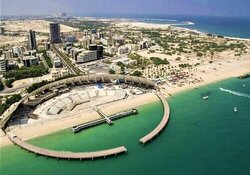
350 packages being prepared to attract foreign investors to free zones

Hojatollah Abdolmaleki also announced about the preparation of two basic strategies in the free zones and added: “Popularization and globalization of the free zones is one of our basic plans for the future of these zones.”
Referring to the potential of the free zones and its direct impact on the country's economy, the official emphasized on strengthening and completing the infrastructure, establishing the international stock market, and completing the economic infrastructure in these zones and said the free zones should connect Iran's economy to the world economy.
Emphasizing the establishment of joint and international free zones, he noted: “We have negotiated with 16 countries for the establishment of joint free zones.”
Underlining that Iran is an investment paradise in the world due to its cheap labor force, cheap energy, excellent geographical location and proximity to several European and Asian countries, Abdolmaleki said, “We are removing bureaucratic obstacles to attract foreign investors in these zones.”
Last December, the secretary of the Free Zones High Council said that this council is seeking to modify the country’s free trade zones (FTZ) comprehensive law.
Speaking in a TV program, Abdolmaleki said, “The good news for the entrepreneurs of the regions, both the current ones and those who, God willing, will soon join us, is that we are looking for the modification of the so-called comprehensive law.”
“The free zones have been relatively successful, although they also had failures; What is our main goal is to guide the free zones to that main path and those goals that are considered in the resistance economy that are the increase of exports and foreign investment and the transfer of technology and also meeting the country's needs”, the official stated.
“We follow two approaches or two general strategies in the new period of management in the free zones. Our first approach is to popularize the free zones and our second approach is to globalize these zones”, he added.
Last August, the previous secretary of the Free Zones High Council announced that the trade balance of the country’s free trade zones has become $35 million positive for the first time in 30 years.
According to Saeid Mohammad, there are currently 15 free trade zones and 33 special economic zones active in the country and the necessary licenses have also been obtained for the establishment of 79 new special economic zones.
The official noted that although the overall trade balance of the free trade and special economic zones together has always been positive, this is the first time that the foreign trade balance of the free trade zones becomes positive separately.
Underlining the important role that free trade and special economic zones play in the country’s economic growth, Mohammad said: “The main function of free zones is to facilitate export, production, foreign exchange, entry of new technologies and promotion of knowledge-based companies.”
The establishment of free trade zones (FTZs) in Iran dates back to the Iranian calendar year 1368 (March 1989 - March 1990) following the fall in the country’s oil income in the preceding year which prompted the government to promote non-oil exports.
The first two free trade zones of Iran were established in the south of the country. The first one was Kish Free Trade Zone established in 1368 on Kish Island in the Persian Gulf and the second one was Qeshm Free Trade Zone established the year after on Qeshm Island in the Strait of Hormuz.
Some five other free trade zones have been also established in the country since then, including Chabahar in southeastern Sistan-Baluchestan Province, Arvand in southwestern Khuzestan Province, Anzali in northern Gilan Province, Aras in East-Azarbaijan Province and Maku in West-Azarbaijan Province, both in the northwest of the country.
The development of existing free trade zones and the establishment of new FTZs has become one of the major economic approaches of the Iranian government.
Source: Tehran Times


Trump weighs using $2 billion in CHIPS Act funding for critical minerals

Codelco cuts 2025 copper forecast after El Teniente mine collapse

Electra converts debt, launches $30M raise to jumpstart stalled cobalt refinery

Barrick’s Reko Diq in line for $410M ADB backing

Abcourt readies Sleeping Giant mill to pour first gold since 2014

Nevada army depot to serve as base for first US strategic minerals stockpile

SQM boosts lithium supply plans as prices flick higher

Viridis unveils 200Mt initial reserve for Brazil rare earth project

Tailings could meet much of US critical mineral demand – study

Kyrgyzstan kicks off underground gold mining at Kumtor

Kyrgyzstan kicks off underground gold mining at Kumtor

KoBold Metals granted lithium exploration rights in Congo

Freeport Indonesia to wrap up Gresik plant repairs by early September

Energy Fuels soars on Vulcan Elements partnership

Northern Dynasty sticks to proposal in battle to lift Pebble mine veto

Giustra-backed mining firm teams up with informal miners in Colombia

Critical Metals signs agreement to supply rare earth to US government-funded facility

China extends rare earth controls to imported material

Galan Lithium proceeds with $13M financing for Argentina project

Kyrgyzstan kicks off underground gold mining at Kumtor

Freeport Indonesia to wrap up Gresik plant repairs by early September

Energy Fuels soars on Vulcan Elements partnership

Northern Dynasty sticks to proposal in battle to lift Pebble mine veto

Giustra-backed mining firm teams up with informal miners in Colombia

Critical Metals signs agreement to supply rare earth to US government-funded facility

China extends rare earth controls to imported material

Galan Lithium proceeds with $13M financing for Argentina project

Silver price touches $39 as market weighs rate cut outlook


















